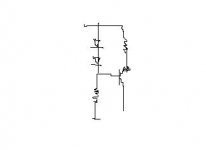Attachments
Maybe there is a formula.
Knowing the actual values for a CCS, in a circuit,
it should be possible to Simulate / calculate what impedance.
Knowing the actual values for a CCS, in a circuit,
it should be possible to Simulate / calculate what impedance.
SY said:That will be (1/hoe) + (Re)(hfe).
thank you very much, but i dont understand the first part "hoe"
can you please explain what it is
fastdata
hoe is the output admittance of the device (it's one of the hybrid parameters). It's not on every spec sheet, but it can be found for many common transistors.
Hi,
one can measure the static impedance.
measure the current that passes at operating voltage. Increase voltage slightly and re-measure the passing current.
[V1-V2]/[I1-I2] = impedance at that current and that voltage.
As one changes the current and/or changes the voltage the impedance varies.
Is there a simple way to measure dynamic impedance?
one can measure the static impedance.
measure the current that passes at operating voltage. Increase voltage slightly and re-measure the passing current.
[V1-V2]/[I1-I2] = impedance at that current and that voltage.
As one changes the current and/or changes the voltage the impedance varies.
Is there a simple way to measure dynamic impedance?
see a decent textbook on this, like Tietze/Schenk, your local university library may have one exemplarySY said:That will be (1/hoe) + (Re)(hfe).
Things are slightly more complicated.
Regards
bjt ccs ...
Hello Juergen Knoop,
read this one, please.
Kind regards,
Darius
Originally #11 posted by Juergen Knoop
see a decent textbook on this, like Tietze/Schenk, your local university library may have one exemplary
Things are slightly more complicated.
Regards
Hello Juergen Knoop,
read this one, please.

Kind regards,
Darius
if Re>>rbe then ra=hfe*rceSY said:Well, yes in that it assumes that Re >> rbe.
if Re<<rbe then ra=rce+µ *Re
Regards
SY said:That will be (1/hoe) + (Re)(hfe).
The question was about impedance. What about the capacitance? 🙂
That's why I use cascodes. 😉
IIRC, Gary Pimm has some nice plots of impedance versus frequency for various CCS at his website.
IIRC, Gary Pimm has some nice plots of impedance versus frequency for various CCS at his website.
Re: bjt ccs ...
There is no need to pursuit it any further.
regards
a literature hint and a formula was given.oldeurope said:
There is no need to pursuit it any further.

regards
Even tho the current stays the same the voltage across the CCS varies with the VAS voltage.
So the impedance will vary with voltage.
In a steady state the impedance will be the voltage across the CCS divided by the constant current.
So the impedance will vary with voltage.
In a steady state the impedance will be the voltage across the CCS divided by the constant current.
>> In a steady state the impedance will be the voltage across the CCS divided by the constant current.
Some misconception here. Impedance is per definition a complex value in the linearized small signal AC domain. While a shifted operating point may affect the impedance, the large signal values of voltage and current (which *are* just that operation point) are not part of the impedance.
http://en.wikipedia.org/wiki/Electrical_impedance
- Klaus
Some misconception here. Impedance is per definition a complex value in the linearized small signal AC domain. While a shifted operating point may affect the impedance, the large signal values of voltage and current (which *are* just that operation point) are not part of the impedance.
http://en.wikipedia.org/wiki/Electrical_impedance
- Klaus
Right Klaus.
Another way to look at it, is that the impedance is the instantaneous rate of change of voltage with current, or the slope of the tangent to the curve of voltage vs current.
Impedance is, of course, complex as it may comprise both resistive and reactive elements.
Brian
Another way to look at it, is that the impedance is the instantaneous rate of change of voltage with current, or the slope of the tangent to the curve of voltage vs current.
Impedance is, of course, complex as it may comprise both resistive and reactive elements.
Brian
- Status
- Not open for further replies.
- Home
- Amplifiers
- Solid State
- ccs impendance formula
